Are you overwhelmed by too many choices and conflicting information when it comes to selecting which fermentation weight to use?
Do you wonder if the fermentation weight of your choice will really work, holding your ferment below the brine not just for the first few days, but for 3-4 weeks?
Ideally, without brine seeping out of your jar or into your airlock or mold growing on the surface?
This post will help you find the best weight for fermenting in mason jars.
Let’s get started.
Please Note. If what you are currently using for a fermentation system is working, don’t feel you need to change it to the latest gadget – or the winning weight – on the market. I would need to do this challenge a few times for it to be super reliable. Fermentation is not an exact science – though I try to make it so.
- The Criteria
- Food for Thought
- Types of Fermentation Weights
- Our 7 Contenders
- Final Standings
- Fermentation Weight Details
- Day 1 of the Fermentation Weight 28-Day Challenge in Pictures
- Day 7 of the Fermentation Weight 28-Day Challenge in Pictures
- Day 14 of the Fermentation Weight 28-Day Challenge in Pictures
- Day 21 of the Fermentation Weight 28-Day Challenge in Pictures
- Day 28 of the Fermentation Weight 28-Day Challenge in Pictures
The Criteria
To find out which fermentation weights work the best, I rounded up seven popular ones to put to a 28-day test. I purchased cabbage, all from the same grower, and made eight jars of plain sauerkraut, topping each off with a different weight. Batch eight was a “control” jar in which no weight was used.
I checked them daily and monitored brine coverage, removing a fermentation weight from the challenge when there was no more brine covering the packed sauerkraut.
I set out to answer the following questions about the various weights. Is the fermentation weight:
- Compact enough to leave room for the brine? During the first week of fermentation, large amounts of water are pulled out of the cabbage cells to create the brine. To allow enough room for this brine, it is recommended that you leave 1-2 inches of headspace in your jar. If the weight takes up a good part of this headspace, there is no room for the brine and it overflows the jar or moves up into your airlock.
- Heavy enough to force bubbles to the surface of the brine? If the weight is not heavy enough or does not apply enough force – as in the spring-style weights – then bubbles remain trapped in the packed mixture, forcing it to “heave” or move upwards. As this happens, your ferment moves out of the safety of the brine and/or brine can overflow the jar.
- Made out of a material you feel comfortable using? Fermentation weights are being made from glass, silicone, plastic and stainless steel each with their own set of pros and cons as I discuss in What materials are safe in the acidic fermentation environment? Can you find a weight that works and is made from your preferred material?
- Strong enough to keep your ferment below the brine for the duration of the fermentation period? Yes, the critical period for your ferment to remain below the brine is during the first 7 days by which time enough lactic acid has been created and the pH of your ferment is low enough to term it safely fermented. However, for a full fermentation and a complete flavor profile, it’s nice to have your ferment below the brine for 3-4 weeks. Is that possible as fermentation slows and the brine is pulled back into the cell walls through osmosis?
- Useful with other types of ferments? Eventually, you’ll find yourself making fermented pastes, relishes, and pickles. Can the fermentation weight work with loose vegetables packed in brine, a thick paste with very little moisture, or one that is mainly liquid?
Food for Thought
As I observed and worked with these weights, the following thoughts and observations came to mind.
Fermenting is best done in the larger environment of a ceramic crock. We are fighting an uphill battle when we ferment in a quart (liter) jar. It can be done – quite successfully. However, it just will come with a few extra challenges.
Fermenting in jars has made it easy for the novice or hesitant individual to ferment. The benefits of fermenting in a jar far outweigh the negatives.
My pie-in-the-sky dream is for each and every one of your to “graduate” to fermenting in a 5-liter – or larger – water-sealed fermentation crock. However, if you remain at the jar stage, I’m still “pleased as punch,” for you have welcomed the microbial world into your home, are mastering a time-honored skill, are connecting with your food, and have an easy – and inexpensive – way to effortlessly add a delicious probiotic-rich food to any meal.
Ambient temperatures impact brine levels. I generally would check on my 28-Day Fermentation Weight Challenge jars in the morning when the temperatures near my jars were are about 68 and mid-afternoon when temperatures were around 72. Often, ferments that were not under the brine at the cooler temperatures were at the warmer temperatures. I took my data during the warmer period of the day.
Brine levels automatically shift as fermentation progresses through the various stages. Through osmosis, the water moves in and out of the cells in the cabbage. During the first week of fermentation, the water moves out to create the brine. After that first week, the brine moves back into the cabbage cells, making it a challenge to have enough brine to keep your ferment covered. With a large crock and the heavier stone weights, this movement does not seem to leave the packed sauerkraut high and dry.
Do we really know the ideal length for fermentation in jars? The research – done with large vats – points to 21 days as being the required length for fermentation to progress through all stages. And I recommend this. Is this time frame the same for a small jar where fermentation should progress more quickly?
I was speaking with the elderly owner of a local blueberry farm. We got to talking about sauerkraut and he mentioned that the sauerkraut he remembered making as a young boy was declared done when the brine levels dropped. That has me thinking. I’ll need to pay him a return visit and ask a few more questions.
Cabbage choice plays an important role. Summer cabbage – grown in early spring and summer and harvested in late summer – will ferment differently than Winter cabbage – grown in the late summer and harvested after the first frost.
I don’t want to keep harping on this because my goal is to have you fermenting sauerkraut. I also don’t want you not fermenting as you wait for that perfect cabbage. But, I did find it harder than usual to create a nice amount of brine with the Summer cabbage I used in this fermentation weight challenge.
High-moisture flavor additions compensate for low-moisture cabbage. If you add grated radish, carrots, beets, etc. to your ferment, they will help compensate for a dry cabbage and you may end up with your ferment below the brine for a much longer time period than I did in this challenge using rather dry cabbage and no additional vegetables.
Types of Fermentation Weights
Looking at the various fermentation weights on the market and the contenders in our fermentation weight challenge, I found it necessary to classify them into three categories in order to help you better understand the various ways in which a fermentation weight works.
Fermentation Weight
A fermentation weight relies upon weight to hold your ferment below the brine.
Most all are made from made from non-iridized soda glass (the same material glass canning jars are made from), a lead-free material that guarantees nothing will leach into your ferment.
Common complaints from users are that they break and some can be difficult to remove from the jar, hence the “handles” on the newer designs.
The major drawback is that they don’t have enough weight to hold your ferment below the brine for the 3-4 week duration of a ferment. However, they seem to keep your ferment below the brine during the critical first week of fermentation.
My Pickle Pebbles range in weight from 5.05 ounces (142 grams) to 5.60 ounces (159 grams). The Easy Weights, 6.2 ounces (176 grams) to 6.4 ounces (182 grams). In contrast, the set of Luna glass weights I use in my Stone Creek Trading water-sealed fermentation crock weigh almost 2.9 pounds (1160 grams). There is a fine line between making them thicker for more weight and making them too thick that there is no room left in the jar for the brine.
An 8-ounce (250 ml) jar of water, capped, weighs 13.15 ounces (373 grams). This is what I used to keep my ferments below the brine for many years with its drawback being that the surface of the brine is exposed to air.

Fermentation Gate
A fermentation gate is a device locked into the neck of the jar to prevent your ferment from moving upwards in the jar or “heaving.” These are being made from food-safe plastic, silicone or even glass.
The plastic Canning Buddies has tabs that hold it in place in the neck of the jar. The silicone Pickle Pusher also has tabs that secure it in place in the neck of the jar. And the small canning jar I use in my teaching recipe relies upon the lid to hold it in place. There is also the plastic No products found. – with gripping teeth on its bottom and a slit on its side for brine seepage – that acts as a fermentation gate.
Fermentation Spring
A fermentation spring relies upon the pressure from a coiled spring to push your ferment down under the brine. These are being made from high-grade stainless steel.
The Kraut Source fermentation lid uses a spring made from a light grade of stainless steel along with a stainless steel plate to push down on your ferment. The The Pickle Helix uses a spring made from a heavier grade of stainless steel that is tightly coiled at the bottom to push down on your ferment.
Our 7 Contenders
The fermentation weight contenders are (pictures and detail below):
The glass 4-Ounce Jelly jar by Ball canning jar company.
The glass Pickle Pebble by MasonTops.
The glass Easy Weight by Nourished Essentials.
The silicone Pickle Pusher by The Ultimate Pickle Jar.
The plastic Canning Buddies by ViscoDisc.
The stainless steel Fermentation Lid by Kraut Source, also referred to as “Kraut Source.”
The stainless steel The Pickle Helix by Trellis & Co.
Final Standings
Below is a table with the ranking order of each of the fermentation weights on Day 28 along with the amount of brine coverage on each. They are listed by mm of brine coverage, from greatest to least.
Please realize this was one test using somewhat dry sauerkraut and no other vegetables for added moisture. All the weights tested work and I feel comfortable recommending any of them. We will each have different selection criteria. Some won’t touch plastic. Others may be fermenting in challenging conditions where it is crucial to have brine coverage for the duration of the fermentation period.
I was totally surprised by the brine coverage when using the small jelly jar. It increased in the last week from 5mm to 18mm! I can’t explain that one for I often find it dry towards the end of fermentation.
Since this challenge, I’ve used the Pickle Helix quite a bit and find it to always have brine coverage at the end of fermentation. Due to the anomaly in the brine coverage for the small jelly jar, I give the Pickle Helix top vote.
And, also interesting was the fact that the control jar with no weight fermented just fine without yeast or mold growth. I fermented in ideal conditions during the fall with ambient temperatures between 64-72° Fahrenheit (18–22° Celsius).
Fermentation Weights Ranked by Brine Coverage on Day 28
I can only show six items in this table, or six boxes if you’re on mobile. So, not pictured is the Pickle Pebble which was dropped from the challenge on Day 7.
Fermentation Weight Details
1. A Small Jelly Jar

I like to use the small jelly jar as a fermentation weight because it is inexpensive, readily available (in North America), keeps things simple for the first-time fermenter and has multiple uses. It’s the perfect-sized jar for sharing sauerkraut samples and can be used to store all sorts of treasures.
As the packed sauerkraut expands, the jar is forced up against the lid preventing the mixture from moving up and out of the brine.
- Ball 4 oz quilt jelly
- Ideal for preserving jams, jellies sauces, mustard & flavored vinegar
- Custom time tested ceiling compound help ensure a quality seal with each lid
2. The Pickle Pebble by Mason Tops
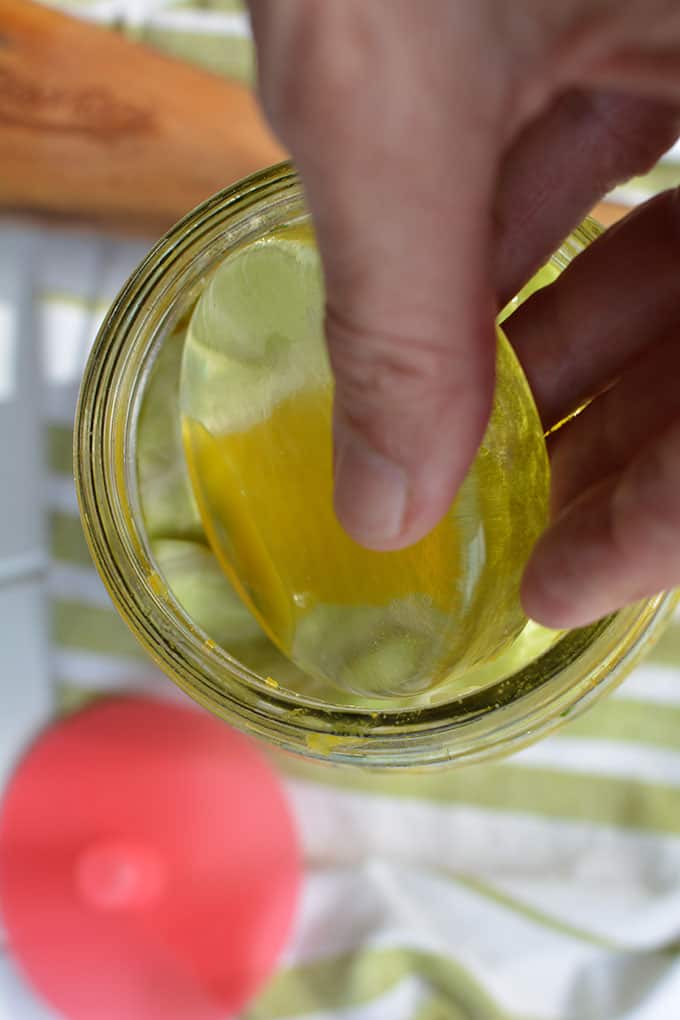
The Pickle Pebble by MasonTops is made from non-iridized soda glass (the same material glass canning jars are made from), a lead-free material that guarantees nothing will leach into your ferment. The first fermentation weight of this style was made by MasonTops – a company located in Toronto, Canada – whose name includes the inventor of the glass canning jar. There are now many other companies selling this style of weight.
My in-depth review of the Pickle Pebble and the Pickle Pipe – my favorite fermentation lid – can be found here.
- DON'T LET YOUR FERMENTING VEGETABLES SPOIL: A critical step in making healthy and delicious...
- CUSTOM DESIGNED FOR MASON JARS: Pickle Pebbles are specially designed by Masontops - the mason...
- FINGER GRIP FOR EASY REMOVAL: Once you're ready to sample your healthy and delicious fermented...
3. The Easy Weight by Nourished Essentials
The Easy Weight by Nourished Essentials is an improvement on the Pickle Pebble. It includes a grooved handled to make removal easier and it is thicker and weighs about 30% more than the Pickle Pebble.
- Effortless Handling: Experience the ease of using our redesigned glass fermentation weights....
- Universal Compatibility: Our weights are tailored for all wide mouth mason jars. Ideal for...
- Superior Quality: Crafted from thick, crack-proof glass, our weights ensure durability and...
4. The Pickle Pusher by the Ultimate Pickle Jar

The Pickle Pusher by The Ultimate Pickle Jar is made from silicone and is “locked” in place in the neck of your jar. The cool thing about the Pickle Pusher is that it is not going anywhere. No matter how hard those Mighty Microbes push up – or if your fermenting mixture “heaves – the Pickle Pusher stays in place. In this picture, the jar is held in the air by the ring on the Pickle Pusher.
My in-depth review of the Pickle Pusher can be found here. It is available both on No products found. and on the company’s website.
No products found.
5. Canning Buddies by ViscoDisc

The Canning Buddies by ViscoDisc rely upon the jar neck and lid to be held in place. The challenge when using Canning Buddies is to pack the jar to just the right height. Too high and you have “brine overflow.” Too low and the Canning Buddies can’t apply their force. I pack my jar with the usual amount of cabbage and then push the Canning Buddies down into the neck of the jar. It works splendidly as seen in my review post on the ViscoDisc Canning Buddies.
6. The Fermentation Lid by Kraut Source

The The Fermentation Lid by Kraut Source moves beyond the concept of a weight to hold a ferment in place and instead makes use of downward force applied by a spring. Also part of the lid set up is a Pickle Plate that prevents most loose bits from floating to the surface.
My in-depth review of the The Fermentation Lid can be found Kraut Source Fermentation Lid REVIEW [Solid Design].
- Makes fermenting foods like sauerkraut, pickles, salsa, kimchi and more fun and easy.
- It fits on standard wide-mouth mason jars*, allowing you make pint, quart, or half-gallon sized...
- Specially designed to keep air out and fermenting fruits and veggies submerged in brine.
7. The Pickle Helix by Trellis & Co.
For the The Pickle Helix by Trellis & Co., founder Josh used his engineering experience with springs to come up with the Pickle Helix. It takes the spring action one step further and applies greater force than the Kraut Source and is tightly coiled at the base to prevent most loose bits from floating to the surface.
The Pickle-Helix can also be purchased in a kit that includes stainless steels lids complete with waterless air-locks.
- INCLUDES: 3 x Pickle Helix Stainless Steel Fermenting Coils (lid & jars not included). BONUS -...
- FERMENT LIKE A PRO: Pro fermenters use nothing but stainless steel why shouldn’t you? The...
- VERSATILE: The Pickle Helix Coil self-adjusts to work with any size mason jar for fermentation....
Day 1 of the Fermentation Weight 28-Day Challenge in Pictures
This is what everything looked like at the end of Day 1 after all jars were packed.
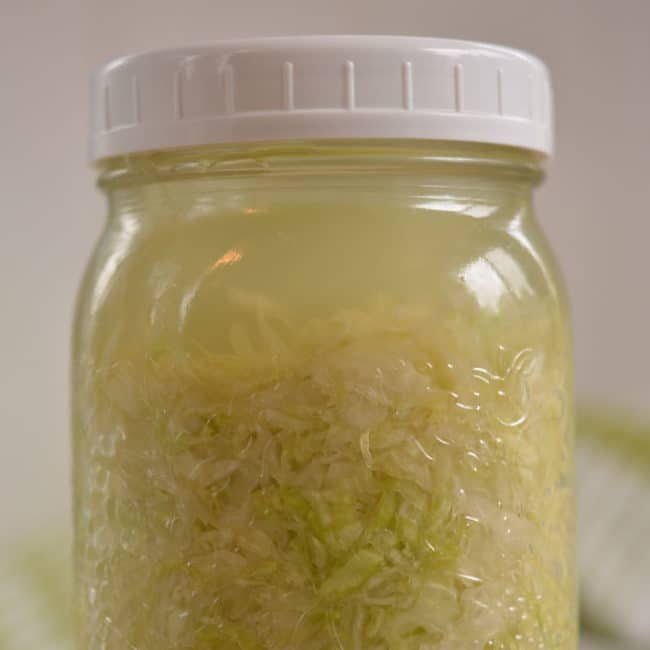
Small Jelly Jar – Day 1
Brine level at middle of lid. Bubbles on surface of brine.

Pickle Pebble – Day 1
Bubbles seen forming around neck of jar. Brine level at middle of lid.

Easy Weight – Day 1
Bubbles seen forming around neck of jar. Brine level at middle of lid.

Pickle Pusher – Day 1
Bubbles seen forming around neck of jar. Brine level at middle of lid.

Canning Buddies – Day 1
Lots of bubbles seen forming around neck of jar. Brine level just below jar threads.
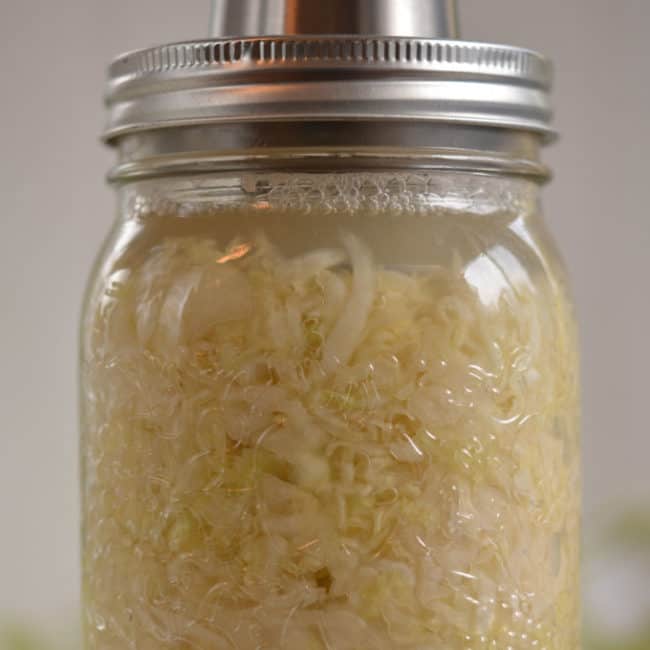
Kraut Source – Day 1
Lots of bubbles seen forming around neck of jar. Brine level just below jar threads.

Pickle Helix – Day 1
Lots of bubbles seen forming around neck of jar. Brine level just below jar threads.

Control, No Weight – Day 1
Few, if any bubbles detected. Some brine just barely covering cabbage mixture.
Day 7 of the Fermentation Weight 28-Day Challenge in Pictures
View the pictures below to see what fermentation weights survived the first week of the 28-day Fermentation Weight Challenge.
Please note that even though one of the contenders “dropped out” on Day 7, all of the fermentation weights worked just fine through the crucial first week of fermentation, by which time enough lactic acid has been created and the pH of your ferment is low enough to term it safely fermented. However, for a full fermentation and a complete flavor profile, it’s nice to ferment it for a couple more weeks.

Jelly Jar – Day 7
8 mm of brine covering sauerkraut. The top of the packed sauerkraut is sitting at 115 mm.

Jelly Jar – Day 7
Some brine in jelly jar. Brine seeped out the jar for the first 4 days.

Pickle Pebble – REMOVED from the Challenge on Day 7
0 mm of brine covering sauerkraut. The top of the packed sauerkraut is sitting at 126 mm.

Pickle Pebble – REMOVED from the Challenge on Day 7
No brine covering the Pickle Pebble. Brine seeped out the jar for days 3, 4, and 5.

Easy Weight – Day 7
21 mm of brine covering sauerkraut (midpoint of Easy Weight)t. The top of the packed sauerkraut is sitting at 127 mm.

Easy Weight – Day 7
Some brine in Easy Weight channels. Brine seeped out the jar for days 3, 4, and 5.

Pickle Pusher – Day 7
20 mm of brine covering sauerkraut (midpoint of Pickle Pusher) The top of the packed sauerkraut is sitting at 135 mm.

Pickle Pusher – Day 7
Brine covering all but top edge of Pickle Pusher. Brine seeped out the jar for days 3, 4, and 5.

Canning Buddies – Day 7
33 mm of brine covering sauerkraut. The top of the packed sauerkraut is sitting at 110 mm.

Canning Buddies – Day 7
Brine covering Canning Buddies. Lots of bubbles on surface.

Kraut Source – Day 7
31 mm of brine covering sauerkraut. The top of the packed sauerkraut is sitting at 119 mm.

Kraut Source – Day 7
Brine covering Pickle Plate. Some floaties. Bubbles around perimeter.

Pickle Helix – Day 7
38 mm of brine covering sauerkraut. The top of the packed sauerkraut is sitting at 100 mm.

Pickle Helix – Day 7
Brine covering base of Pickle Helix. Bubbles around perimeter and clinging to Pickle Helix.

Control Jar, No Weight – Day 7
Brine level below top of packed sauerkraut. You can tell by the color change.

Control Jar, No Weight – Day 7
No brine covering packed sauerkraut.
Day 14 of the Fermentation Weight 28-Day Challenge in Pictures

Small Jelly Jar – Day 14
13 mm of brine covering sauerkraut. The top of the packed sauerkraut is sitting at 110 mm. (This is a bit more brine than on Day 7; I did pour the brine in the jelly jar into the ferment.)
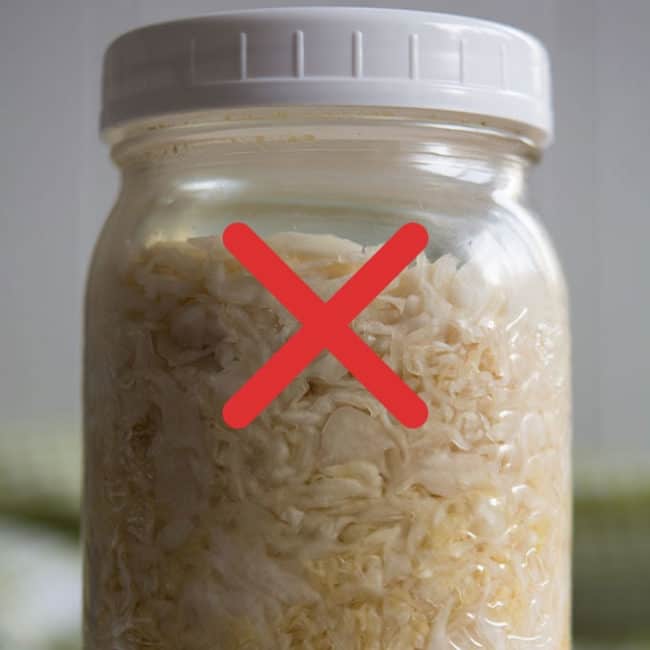
Pickle Pebble – REMOVED from the Challenge on Day 7
0 mm of brine covering sauerkraut. The top of the packed sauerkraut is sitting at 126 mm.

Easy Weight – Day 14
1 mm (was 21 mm on Day 7) of brine covering sauerkraut. The top of the packed sauerkraut is sitting at 126 mm.
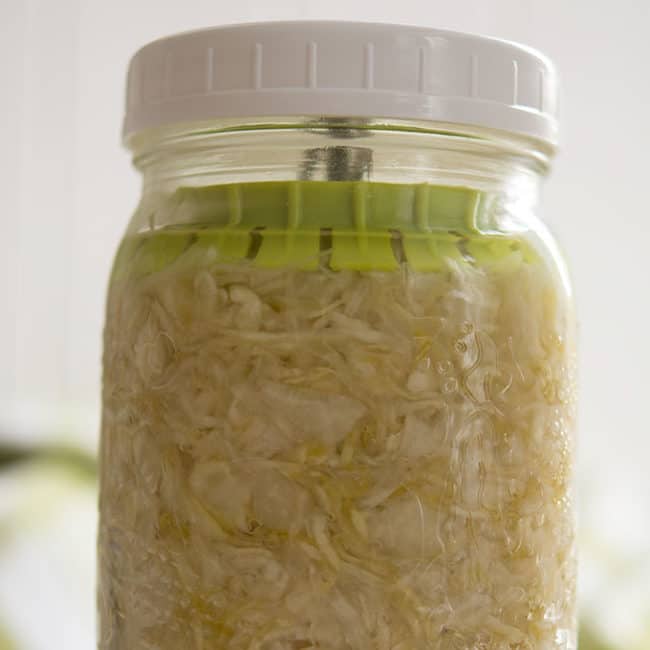
Pickle Pusher – Day 14
6 mm (was 20 mm on Day 7) of brine covering sauerkraut. The top of the packed sauerkraut is sitting at 126 mm. I inserted the rod to see if that would exert some force on the packed sauerkraut. It made a bit of difference since the lid is pushing down on the top of the rod.

Canning Buddies – Day 14
9 mm (was 33 mm on Day 7) of brine covering sauerkraut. The top of the packed sauerkraut is sitting at 110 mm.

Kraut Source – Day 14
1 mm (was 31 mm on Day 7) of brine covering sauerkraut. The top of the packed sauerkraut is sitting at 120 mm.

Pickle Helix – Day 14
14 mm (was 38 mm on Day 7) of brine covering sauerkraut. The top of the packed sauerkraut is sitting at 110 mm.
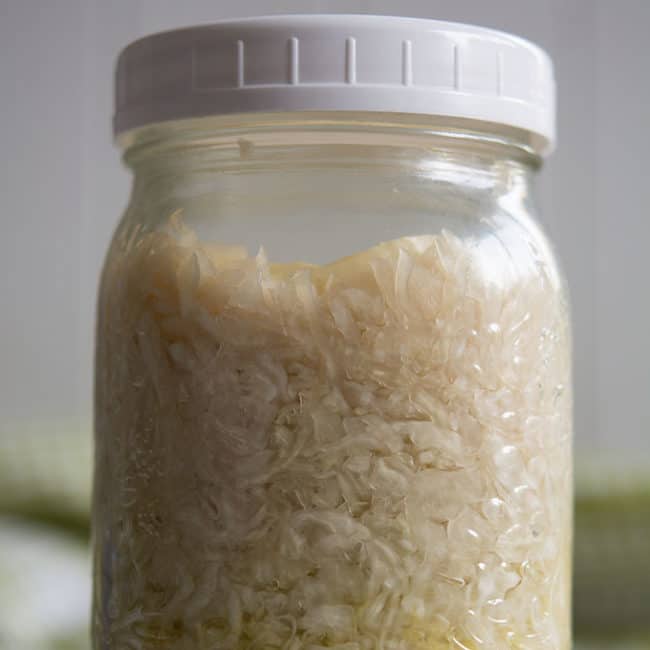
Control, No Weight – Day 14
No brine covering packed sauerkraut.
On all of the jars, brine coverage decreased as the active fermentation stage finished. When using a fermentation weight, as with the Pickle Pebble and Easy Weight, more weight helps but it doesn’t seem that you can make a weight that is heavy enough and yet not take up all the space needed for the brine.
When using a fermentation gate, as with the jelly jar, Pickle Pusher or Canning Buddies, how full you pack the jar is critical in order for them to exert the necessary force, to get the brine to rise to the surface.
When using a fermentation spring, the spring’s force places an important factor. The wire used in the Kraut Source is made from a much lighter gauge than what is used in the Pickle Helix. There is a big difference in brine coverage between the two.
Day 21 of the Fermentation Weight 28-Day Challenge in Pictures

Small Jelly Jar – Day 21
5 mm of brine covering sauerkraut.

Pickle Pebble – REMOVED from the Challenge on Day 7
0 mm of brine covering sauerkraut.

Easy Weight – REMOVED from the Challenge on Day 16
0 mm of brine covering sauerkraut on Day 16.
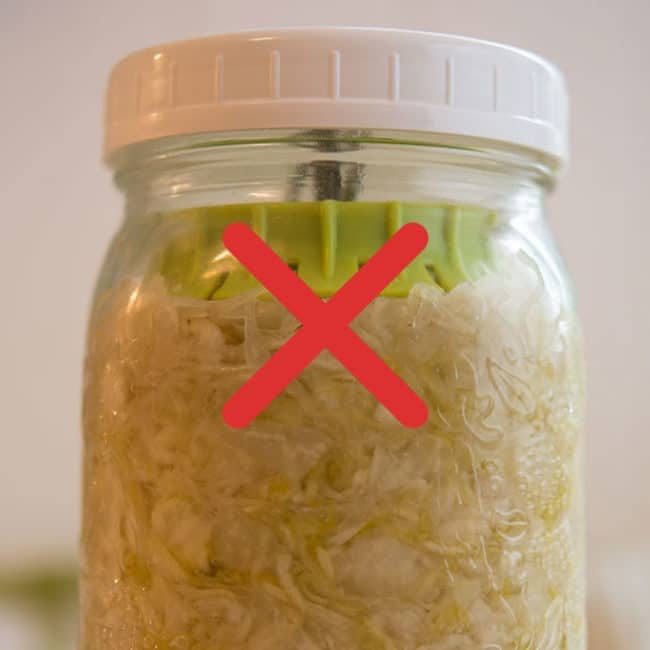
Pickle Pusher – REMOVED from the Challenge on Day 18
0 mm of brine covering sauerkraut on Day 18.

Canning Buddies – Day 21
10 mm of brine covering sauerkraut.

Kraut Source – Day 21
1 mm of brine covering sauerkraut.

Pickle Helix – Day 21
11 mm of brine covering sauerkraut.

Control, No Weight – Day 21
No brine covering packed sauerkraut.
Day 28 of the Fermentation Weight 28-Day Challenge in Pictures

Small Jelly Jar – Day 28
18 mm of brine covering sauerkraut.

Pickle Pebble – REMOVED from the Challenge on Day 7
0 mm of brine covering sauerkraut.

Easy Weight – REMOVED from the Challenge on Day 16
0 mm of brine covering sauerkraut on Day 16.
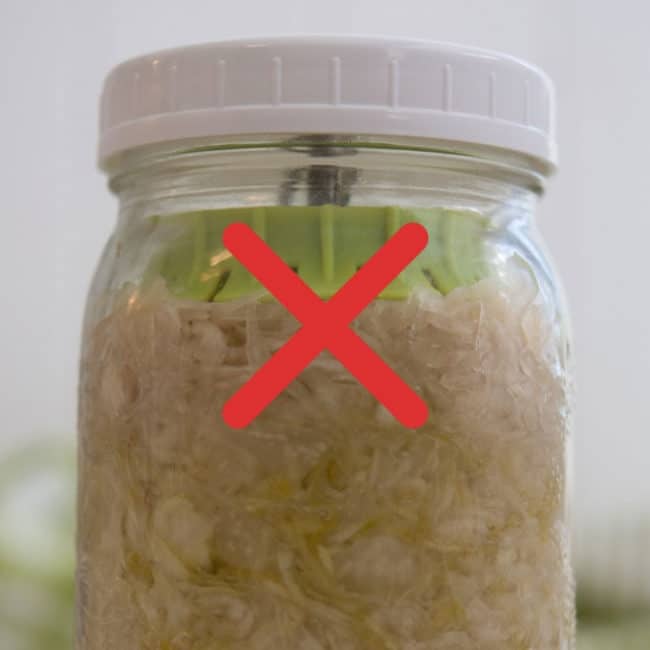
Pickle Pusher – REMOVED from the Challenge on Day 18
0 mm of brine covering sauerkraut on Day 18.

Canning Buddies – Day 28
11 mm of brine covering sauerkraut.

Kraut Source – Day 28
1 mm of brine covering sauerkraut.
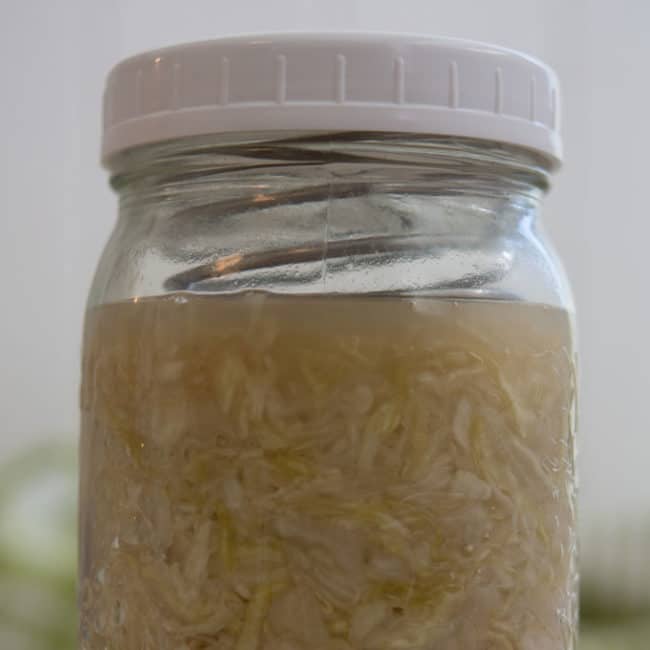
Pickle Helix – Day 28
12 mm of brine covering sauerkraut.

Control, No Weight – Day 28
No brine covering packed sauerkraut.
There was a surprise move for one of the fermentation weights during the last week of the challenge. I have no idea why suddenly brine levels increased in the jar using the small jelly jar.
What fermentation weight do you use and why?
Please leave any comments or questions below.
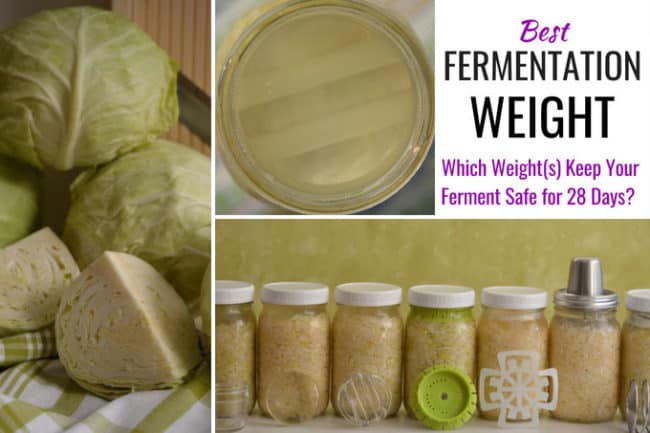
Last update on 2024-07-26 / Affiliate links / Images from Amazon Product Advertising API



 This post may contain affiliate links which won’t change your price but will share some commission.
This post may contain affiliate links which won’t change your price but will share some commission.


